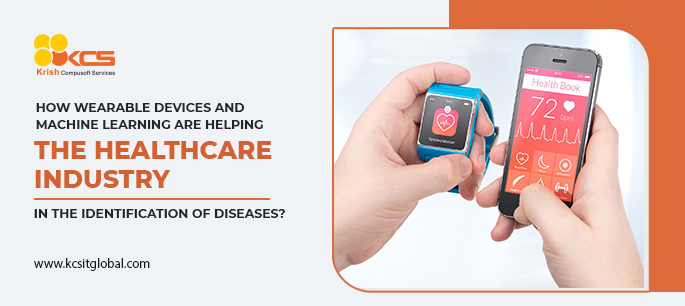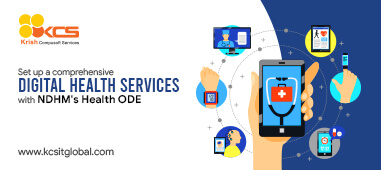
Category: Digital Transformation
How wearable devices and machine learning are helping the healthcare industry in the identification of diseases?
Statista report shows that 325 million people are using at least one wearable or connected device, and more than 2.5 billion own smartphones globally. Leveraging technology for disease diagnostics can create a significant positive impact. In this document, we will discuss how machine learning and smart wearable technology can serve the healthcare industry in streamlining the identification of diseases.
How wearable devices are magnifying the medical industry?
ClinicalTrials.gov, lists approximately 200 trials with wearable technology in the description. This contains wearable devices designed for medical purposes and testing various medical devices with the help of wearable technology. For instance:
- A study analyzing the feasibility of clinical trials using Garmin watches to diagnose atrial fibrillation
- A study evaluating the efficiency of Fitbit for diagnosing sleep apnea
- A study determining the accuracy of wearable, automated bionic pancreas system that gives both insulin glucagon to children with diabetes
- A study assessing the utility of clinical trials using a wearable device to enhance arm movement in patients who have had a stroke
Today, late diagnosis of disease leads to delayed treatment and recovery is a very common occurrence. How about if you could diagnose a disease even before it appeared in an individual’s body. Machine learning and wearable technology are two technologies that are now used globally to reduce the diagnosis time of many diseases like COVID-19 and Cancer.
In recent research, published in Radiology, Jae Ho Sohn combined neuroimaging and machine learning in order to predict whether or patient will develop Alzheimer’s disease when they initially presented with memory impairment – the best time to intervene.
For training the algorithm, Sohn added images from the Alzheimer’s Disease Neuroimaging Initiative (ADNI), a significant public dataset of Positron Emission Tomography (PET) scans from patients who were diagnosed with either Alzheimer’s disease, tranquil cognitive impairment, or no disorder. Eventually, the algorithm started to learn on its own which features are essential for forecasting the diagnosis of Alzheimer’s disease and which are not.
As per MIT news, a team from Massachusetts Institute of Technology’s Computer Science and Artificial Intelligence Laboratory (CSAIL) and Massachusetts General Hospital (MGH) developed a new model that can predict from a mammogram whether a woman is likely to develop breast cancer as much as five years in the future.
How Machine Learning and Wearable technologies are helping the healthcare industry in the identification of diseases?
1. Resolves issues with processing data:
Most clinical researchers are not disciplined in processing a significant amount of raw and unfiltered data that are captured via wearable devices. They must eliminate invalid data, understand which set of data are needed to manage an audit trail, and which data should be reported as a final result. There might also be differences in how data is recorded and stored from one device to another, which can make consistency problems.
2. Develop drugs faster:
Developing a drug is a significantly expensive process. Several analytical processes included in drug development can be made more efficient using machine learning technology. This has the power to eliminate years of work and hundreds of millions in investments. In general, there 4 stages of drug development:
- Identifying targets for intervention
- Discovering drug candidates
- Speeding up clinical trials
- Finding biomarkers for diagnosing the disease
Machine learning and artificial intelligence can be used successfully in all the stages of drug development. It can quickly analyze all the available data and can also learn to automatically detect good target proteins. Machine learning can learn to estimate the legitimacy of a molecule on the basis of structural fingerprints and molecular descriptors. Later, they can implode through millions of potentials molecules and filter them down to the best options. This will eventually save a lot of time for drug design.
3. Resolving ethical and legal challenges:
While data retrieved from medical devices is secured by patient privacy laws, those same protections do not apply to customer-grade wearable devices like a fitness tracker. Data captured by customer-grade devices might contain private health information that could be shared in a cumulative form without explicitly mentioning who will have access to it.
However, in the European Union, the new General Data Protection Regulation does not differentiate between device types. It states that all data produced by wearable devices or applications have clearly defined purposes for use. Users should consent to have their data from these devices reused, and they might withdraw their consent at any point in time.
4. Personalized treatment:
Different patients react to drugs and treatment schedules differently. Hence, personalized treatment has significant power to enhance patient’s lifespans. But it is very difficult to recognize which factors must affect the choice of treatment. Machine learning can automate this complex statistical task and help identify which symptoms signify that a patient will have a particular response to a particular treatment.
Therefore, the algorithms can forecast a patient’s probable response to a particular treatment. The system will understand this by cross-referencing similar patients and compare their treatment and results. The resulting outcome predictions streamline the process of designing the right treatment plans for doctors and healthcare professionals.
Conclusion :
Artificial intelligence is already helping us more effectively diagnose disease, develop a drug, bespoke treatment, and even edit genes. But this is just the beginning. Researchers who are planning the use wearable devices in clinical trials require to identify these factors as they develop their study protocol and conduct risk analysis. They must understand what type of wearable devices are applicable to use and understand how various types of devices can impact data collection.
Recent posts
-
Top Trends in Modern Workplace
March 15, 2022
-
Top 4 Microsoft 365 Collaboration tools to Improve Business Productivity
November 29, 2021
-
4 Ways to Get Your Data in the Cloud with Azure Data Migration
November 12, 2021
Articles
-
How Utilities are Adapting to the ‘New Normal’ Post Pandemic in the Realm of Customer Experience (CX)
February 02, 2022
-
How Enterprise Logic Apps Create Business Value for Azure Users
November 15, 2021
-
Accelerate Your Journey To Smart Manufacturing Transformation - The Ecosystem Approach
October 26, 2021











